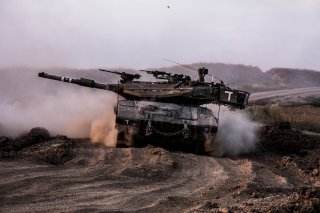Tank War: Israel's Merkava Tank vs. America's M1 Abrams (Who Wins?)
The Israeli Merkava (Chariot) main battle tank is an example of a sophisticated weapon system designed to deal with very specific national requirements.
There are also modifications to accommodate the basic human needs of the crew. For example, the Merkava boasts a top-notch air conditioning system befitting its Middle Eastern stomping ground. There is even has an optional toilet module to protect the crew from exposing themselves to hostile fire on very long missions. As depicted in the Israeli war film Lebanon, tank crews have sometimes been forced to remain in action for days on counterinsurgency operations.
Ultimately, the Merkava IV and M1A2 are both designed according to different national doctrines and operational requirements. The U.S. tank is meant to fight rapid Blitzkrieg-style wars with enemy tanks as its chief target, while the Merkava is expected to fight defensive battles and provide support to counterinsurgency operations in urban and mountain terrain. The M1 benefits from certain technologies unavailable to Israeli industry, notably in depleted uranium armor and ammunition. On the other hand, the Merkava has long had a greater emphasis on crew convenience and protection.
If the Merkava IV offers any lessons to the U.S. military, it should be regarding the importance of fielding effective countermeasures against more advanced anti-tank missiles such as the Kornet, which the U.S. military has so far only encountered in limited numbers. The Merkava IV’s combat experience with the Trophy APS suggests that implementing such an upgrade to the U.S. tank fleet could significantly improve its survivability.
Sébastien Roblin holds a Master’s Degree in Conflict Resolution from Georgetown University and served as a university instructor for the Peace Corps in China. He has also worked in education, editing, and refugee resettlement in France and the United States. He currently writes on security and military history for War Is Boring.
This appeared last year and is being reposted due to reader interest.
Image Credit: Creative Commons.

